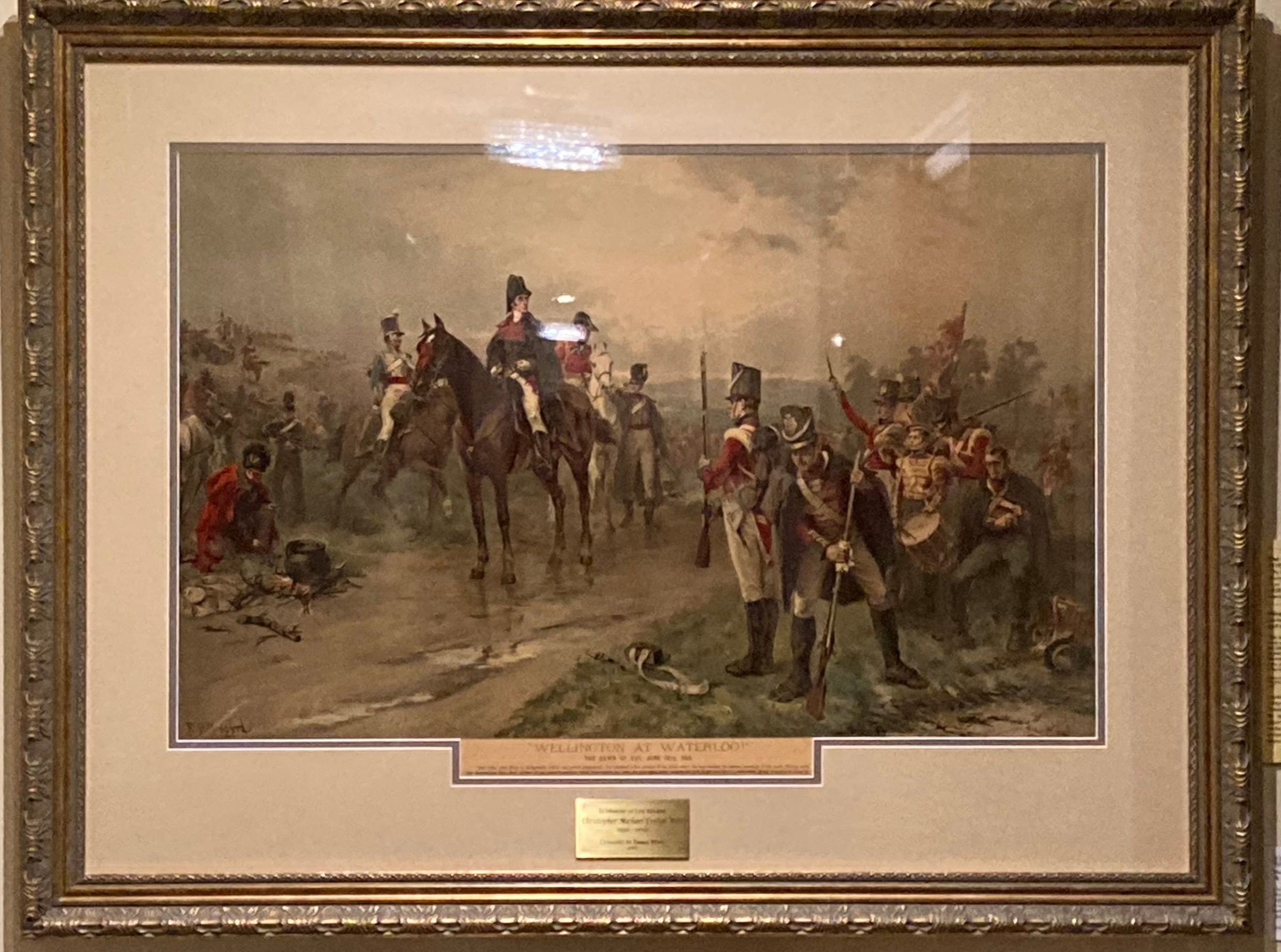Name/Title
Wellington at Waterloo. The Dawn of the Day, June 18th, 1815Entry/Object ID
2001.02.01Description
Print
Reproduction print (1896) after oil painting (date unknown) by Robert Alexander Hillingford. Published in the supplement to "Holly Leaves", "The Illustrated Sporting and Dramatic News Christmas Number November 28th, 1896", London, England.
The central figure on horseback is Arthur Wellesley, 1st Duke of Wellington, KG, KB, MP at dawn on the day of the Battle of Waterloo on Sunday, June 18, 1815, near Waterloo in Belgium, part of the then United Kingdom of the Netherlands. At Waterloo, Wellington commanded the allied army which, together with a Prussian Army under Field Marshal Gebhard von Blücher, defeated Napoléon Bonaparte. Napoléon was forced to abdicate, bringing an end to the Napoléonic era of European history.Artwork Details
Medium
Chromolithograph on paperSubject Place
Region
Western EuropeContinent
EuropeContext
This image reportedly represents a moment just before the battle as described by Sergeant-Major Edward Cotton (late of the 7th Hussars) when the Duke of Wellington surveyed his troops riding to Hougoumont Château and farm. Hougoumont became an epicenter of fighting in the Battle of Waterloo as it was one of the first places where British and allied forces faced Napoléon's army.
- From " A Voice from Waterloo, A History of the Battle Fought on the 18th June 1815", London, 1817.
"The morning of June 18, 1815 saw 180,000 men, 60,000 horses and 500 pieces of artillery crammed into 2½ sq miles of Belgian countryside. In the nine frantic hours that followed, a quarter-century of central European warfare was brought to a close, leaving more than 44,000 dead, dying and wounded on the field. It was an extraordinary event."
Extract from The Battle of Waterloo, Extraordinary Edition, 2015 (See Web Links below).
___________________________
Born in Dublin, the Duke of Wellington (1769-1852) was an Anglo-Irish soldier and Tory statesman who was one of the leading military and political figures of 19th century Britain, serving twice as British prime minister, 1828-1830 and in 1834. He was a leading figure in the House of Lords until his retirement and remained Commander-in-Chief of the British Army until his death. He was known for his consistent political resolve and is considered to be one of the greatest defensive commanders of all time, with many of his tactics and battle plans still studied in military academies worldwide.
Born in Corsica, Napoléon Bonaparte (1769-1821) was a French military commander and political leader who rose to prominence during the French Revolution, leading successful campaigns during the Revolutionary Wars. He was in effect the leader of the French Republic as First Consul 1799-1804, then becoming the French Emperor, 1804-1814 and 1815. His legacy endures, as liberal reformer, controversial leader and one of the greatest military commanders in history. And like Wellington, his military tactics and campaigns continue to be studied across the globe.
_____________________________
The Battle of Waterloo, and the defeat of Napoléon, was significant in many ways. It marked the end of some 750 years of sporadic Anglo-French conflict, and also roughly the end of French domination on the European and world stage and the start of England's supremacy. Of note, there followed almost four decades of international peace in Europe. No further major international conflicts occurred until the Crimean War in the 1850s.Made/Created
Artist Information
Artist
Robert Alexander Hillingford, RA (1828-1904)Role
PainterArtist
UnknownRole
PrintmakerDate made
1890Time Period
19th CenturyNotes
ARTIST BIOGRAPHY
Born in London, Robert Alexander Hillingford was a very successful English painter of historical and literary scenes. He is most famous for his paintings of the Napoléonic Wars, as well as Shakespearean subjects. He studied at the Kunstakademie Düsseldorf in Germany from 1841 to 1845 and is associated with the Düsseldorf school of painting.
Following his studies, he then traveled and painted in Italy for several years, returning to London in 1864 with his first exhibition at the Royal Academy several years later. At this time, he began to focus on historical subjects, often detailed battle scenes especially of the Napoléonic Wars. He exhibited some 30 paintings at the Royal Academy between 1864 and 1902, as well as at the British Institution and the Royal Society of British Artists.Inscription/Signature/Marks
Type
Signature, InscriptionLocation
Signed lower left: R. Hillingford
Lower centre below image:
"WELLINGTON AT WATERLOO!"
THE DAWN OF THE DAY, JUNE 18th, 1815.
"THE Duke rode down to Hougoumont before the the action commenced, and remained a few minutes at the point where the lane reaches the eastern boundary of the wood. Having made his observations upon that portion of the enemy's position which came under his view, he proceeded back towards the left of his own line" --- SIBORNE'S History of the Waterloo Campaign*
________________________
*The "History of the Waterloo Campaign" is regarded as the most comprehensive account of the campaign in the English language, although its objectivity was and still is a source of debate. The author, William Siborne, was a military officer who constructed an enormous model of the battle, and then based on his exhaustive research, he completed his account of the action. His studies including correspondence amounted to the largest single collection of primary source material on the subject, and is now in the British Library.Dimensions
Dimension Description
SupportHeight
51.4 cmWidth
79.4 cmAcquisition
Acquisition Method
GiftDate
2002Notes
Legacy collection
Plaque: In memory of [UCBC] Life Member Christopher Michael Evelyn West 1930-2001. Donated by Emma West, 2002


